masonic heroes of the american revolution
by George F. Harrington, 32°, K.C.C.H.
Masons were leaders central to the success of the American
Revolution
It is particularly appropriate to honor and recall the exploits of so many of
our Founding Fathers this month when we observe Independence Day, July 4. Many
of these patriots were Masons, and their lives form illustrious examples of
courage. Most Americans know, for example, the main outlines of the lives of
such famous Masons as George Washington, Paul Revere, John
Paul Jones, the Marquis de Lafayette, Henry Knox, Joseph Warren, Baron Von
Steuben, and Richard Montgomery. However, there are other Brethren, less known
than these, who contributed greatly to the creation and preservation of our
country. Here are brief sketches of a few of them.
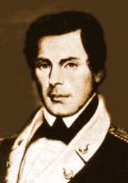 |
Bro. Samuel
Nicholas
Born in Philadelphia in 1744, was a successful
businessman. On November 10, 1775, Congress commissioned him to organize
and train five companies of marine forces, skilled in the use of small and
large firearms, to protect America's ships at sea. They soon ably
demonstrated these capabilities and were successful in forays in the
Bahamas where they captured a large quantity of military supplies sorely
needed for the war effort. During the winter of 1776–77, they provided
reinforcements for Washington's small army, helped with the boats for
crossing the Delaware River at Trenton, and fought in the Battle of
Princeton. Though he never carried the title while he lived, Nicholas is
considered the first Commandant of the Marine Corps. His achievements
certainly exemplify the Marine motto Semper Fidelis. |
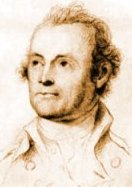 |
Bro. John
Glover
Born in 1732 and raised in Marblehead, Massachusetts,
became wealthy from his fishing and mercantile enterprises. Commissioned
to head the Marblehead Regiment after the Battle of Lexington, he joined
General Washington at Cambridge where his men were trained for naval
operations. They successfully engaged the British at sea and, later,
triumphed over severe odds to evacuate the desperate remnants of
Washington's army from Long Island to Manhattan. Had they not succeeded,
the tide of the war would have completely changed. Bro. Glover and his
forces were again challenged when called upon to ferry Washington's forces
across the Delaware River on the famous Christmas Eve raid. Not only were
they successful in moving Washington's troops to Trenton, they also
carried back 950 prisoners to the Pennsylvania shore. He later
participated in the Saratoga and Rhode Island campaigns. Clearly, his
exploits were vital to the war effort.
|
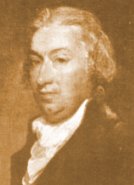 |
Bro. Robert R.
Livingston
Born in New York in 1746, was a well-known lawyer,
diplomat, and statesman. He served in the Second, Third, and Fourth
Provincial Congress of New York from 1775–1777, as well as a delegate from
New York to the Continental Congress for the same years. Although he was a
member of the Committee which drafted the Declaration of Independence, he
did not sign the final document due to absence in New York to attend a
meeting of the Fourth New York Provincial Congress. He became the first
Chancellor of the State and, as such, he administered the oath of office
to George Washington at the 1st Presidential inauguration in New York on
April 30, 1790. He later became minister to France and, in association
with James Monroe in 1803, brought about a great bargain for the U.S., the
Louisiana Purchase. He had broad interests and, after retiring in 1804,
became involved in improving agriculture, such as introducing gypsum as a
fertilizer. He was also instrumental in the development of the steamboat
with Robert Fulton.
|
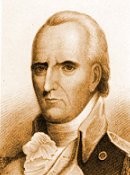
|
Bro. and Maj. Gen. John
Stark
Born in New Hampshire in 1728, used the skills learned
from a life on the frontier when he was commissioned a Lieutenant in the
French and Indian War. Then, in 1775, he was commissioned a Colonel,
fought at Bunker Hill, helped the fortifying of New York, and then joined
General Gates in the Canadian Expedition. He returned to participate in
the battles of Morristown and Short Hills. When he died in 1822, he was
the last surviving General Officer of the Revolution. |
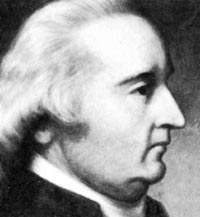 |
Bro. William
Whipple
Born in 1730 in Maine, went to sea, and, at age 29, he
established a mercantile business in New Hampshire. A member of several
committees of the Continental Congress, he was commissioned a Brigadier
General in the New Hampshire militia in 1777 and served with distinction
in the battles of Stillwater and Saratoga where he arranged the surrender
of General Burgoyne. After helping to evict the British from Rhode Island,
he returned to the Continental Congress, serving with distinction until
1782, when he was appointed Judge of the Superior Court in New
Hampshire.
|
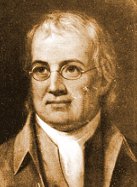 |
Bro. William
Ellery
A signer from Rhode Island of the Declaration of
Independence and the Articles of Confederation, was born in Newport in
1727. After graduating with honors from Harvard College, he tried a number
of careers before deciding to study law. He left his thriving practice to
join the Sons of Liberty and was elected to the General Congress each year
until 1786. He described his experience of the signing of the Declaration
of Independence: "I was determined to see how they all looked as they
signed what might be their death warrant. I eyed each closely as he
affixed his name to the document. Undaunted resolution was displayed in
every countenance." Although recognized as one of the ablest and most
influential members of Congress, Bro. Ellery retired in 1786 and accepted
an appointment from George Washington to serve until his death as U.S.
Collector of Customs for the District of Newport, a busy and active port
of commerce. |
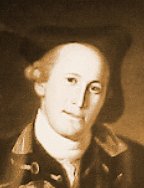 |
Bro. Mordecai Gist
Born in Maryland in 1742, grew up in Baltimore and ran a successful
shipping business. In 1775, he took part in organizing the Baltimore
Independent Company of Militia which, in 1776, was part of the contingent
sent to help Washington in New York. Instrumental in delaying the British
at the Battle of Brooklyn Heights, he attended the Convention of Military
Lodges at Morristown, New Jersey, and was elected its President on January
9, 1780. Though unsuccessful, one of this convention's resolutions was to
recommend an American Grand Lodge with George Washington as Supreme Grand
Master. Gist became Worshipful Master of the Maryland Military Lodge whose
records were captured by the British at the Battle of Camden, South
Carolina, August 16, 1780. However, these records were later returned to
General Gist by Lord Cornwallis, the British General, himself a Mason, who
surrendered at Yorktown. |
 |
Bro. John
Marshall
Born in a Virginia cabin in 1755, had little formal
education, but after reading law on his own, he took a six-week course at
William and Mary College and was accepted by the bar. Impressed by Patrick
Henry's memorable speech—"Give me liberty or give me death" before the
Virginia House of Burgesses—both John and his father, Thomas Marshall,
joined the "Minute Men" and were involved in actions at Great Bridge and
Norfolk. Both served in the same regiment of the Continental Army at
Valley Forge and fought at Brandywine, Monmouth, Germantown, Stony Point,
and Yorktown. John returned to the House of Burgesses and served in the
U.S. House of Representatives and as U.S. Secretary of State before
becoming Chief Justice of the U.S. Supreme Court. In this position, he
ruled on fundamental legal decisions which have shaped our nation ever
since. |
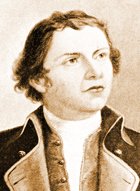 |
Bro. General Hugh
Mercer
Born in Scotland in 1725 and received a medical
education there prior to joining the army as a surgeon's mate. He
immigrated to the Colonies and established a medical practice in
Pennsylvania. He participated in the French and Indian War where he met
George Washington who persuaded him to move to Fredericksburg, where he
returned to his medical practice and became, like Washington, a Mason in
Fredericksburg Lodge No. 4. When the Revolutionary War broke out, he
returned to his military career, and the Continental Congress appointed
him a Brigadier General. He took part in the crossing of the Delaware, and
his troops were in the lead into Trenton on that historic December 26,
1776. At the Battle of Princeton, his horse was shot out from under him,
and he was killed on the ground by British troops. |
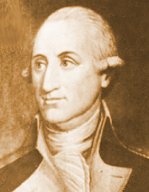 |
Bro. John Peter Gabriel
Muhlenburg
Born in Pennsylvania in 1746, was the son of Henry
M. Muhlenburg, the founder of the Lutheran Church in America. He traveled
in Germany to study theology and returned to the Colonies in 1766 to
become a pastor of Lutheran Churches in New Jersey. He moved to Woodstock,
Vermont, in 1772, but in accordance with the practice of the day, he was
required to go to England to be ordained an Episcopal priest before he
could collect tithes. When he returned to America, he was assigned to an
Episcopal parish in Virginia. A friend of George Washington and an ardent
patriot, he became a Colonel in the army. He dramatically ended a famous
sermon with these words: "There is a time for all things—a time to preach
and a time to pray; but there is also a time to fight, and that time has
now come." He quickly removed his clerical robes, revealing his Colonel's
uniform, proceeded to the door, ordered drums to beat for recruits, and
300 members of his congregation responded. This group became the 8th
Virginia Regiment or "German Regiment," and Bro. Muhlenburg successfully
engaged in a number of battles. After the War, he returned to Pennsylvania
to become a U.S. Congressman. He was elected Senator in 1801 but never
served, having resigned to accept an appointment from President Jefferson
as Supervisor of the Revenue for Pennsylvania and collector of customs at
the port of Philadelphia. |
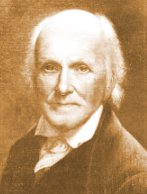 |
Bro. Charles Wilson
Peale
Born in 1741 in Chestertown, Maryland, studied under the
famous artist Benjamin West in England, perhaps becoming exposed there to
other Masons who were forming opposition to their colonial status.
Returning to Annapolis in 1774, he began his career as a portrait painter
but then volunteered for service in the Revolutionary War, serving as a
Captain in the Battle of Trenton and Germantown before being elected to
the Maryland State Legislature. As America's most accomplished formal
portraitist, he was much in demand by the celebrities of that period and
managed 14 sittings with George Washington, who was well known for
limiting such imposition on his time. He painted many other famous
Freemasons, including Hancock, Von Steuben, Franklin, Randolph, Jackson,
and Clay. |
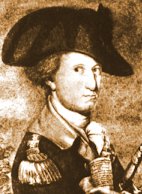 |
Bro. James
Jackson
Born in England in 1757, immigrated to Georgia at the
age of 15. He was placed with a prominent Georgian family and began
reading the law at the Savannah firm of Samuel Farley, a Freemason. When
the war came, he already had demonstrated his strong belief in the cause
and was instrumental in framing Georgia's first State Constitution. He had
enlisted early in the militia, and when the British took Georgia, he rose
to the rank of Colonel with distinguished service in battles in Georgia,
South Carolina, and North Carolina. When the British were forced from
Savannah, he, at the young age of 25, was assigned command of the city and
eventually was promoted to Major General in the Georgia Militia. After the
War, he embarked on a political career as Governor, U.S. Congressman, and
U.S. Senator. He died in Washington and is buried in the Congressional
Cemetery. |
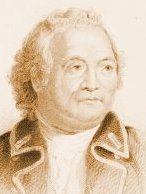 |
Bro. Israel Putnam
Born in 1718 in
Massachusetts, farmed until he volunteered to serve in the French and
Indian Wars. Made a Mason by a British Army Lodge, he performed so well
militarily that he was named to head the Connecticut Militia. Captured by
the Indians in a skirmish, he was rescued by French officers and
eventually was released in a prisoner exchange. After returning to farming
in Connecticut, he heard there was fighting at Lexington and Concord, left
the field he was plowing, saddled his best horse, joined Dr. Joseph Warren
in Massachusetts, was placed in charge of training the volunteers, and was
directly involved in the Battle of Bunker Hill. He was at Warren's side
when Warren fell and was the only Major General to serve from the start to
end in the Revolution. When he died in 1790, over 3,000 people attended
his funeral in Brooklyn, Connecticut, a small rural
town. |
back to top |
![]()


















